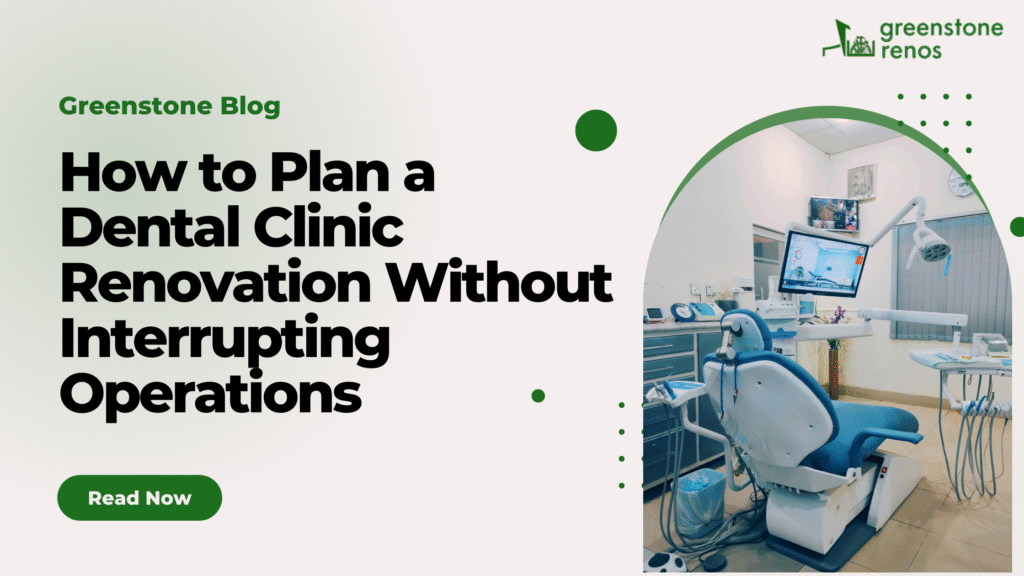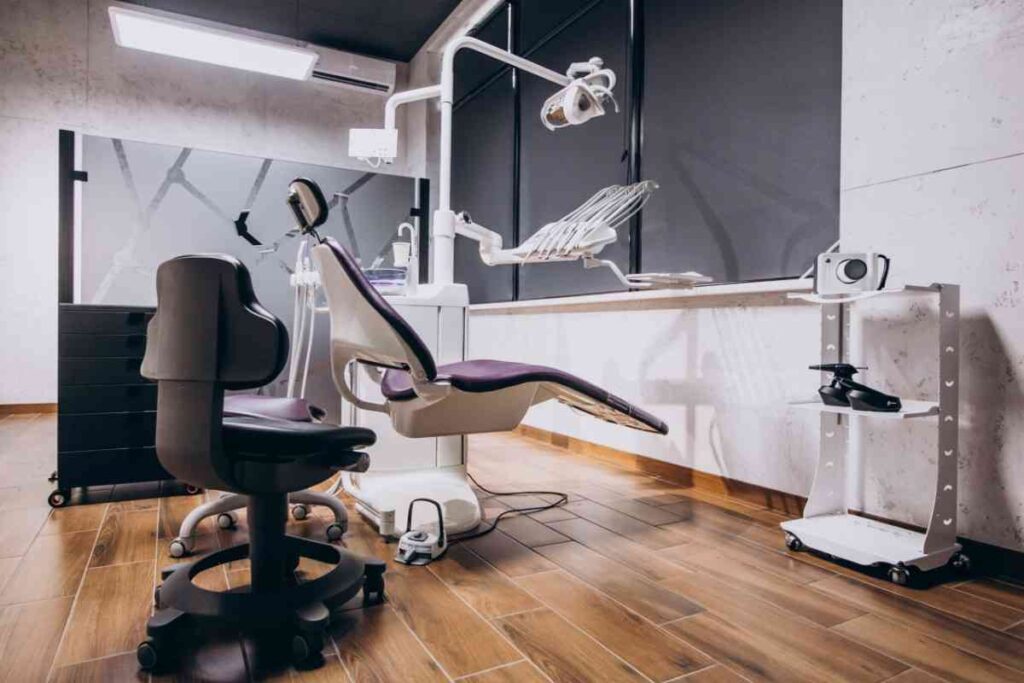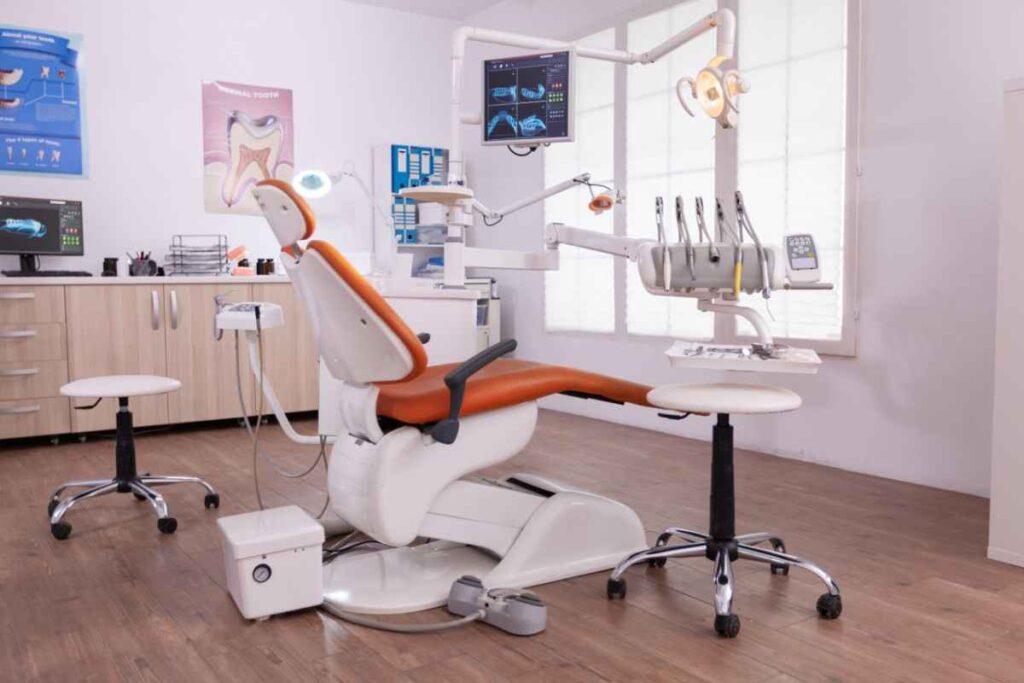How to Plan a Dental Clinic Renovation Without Interrupting Operations

Renovating a dental clinic is great-sounding—but closing your doors and having to turn away patients is daunting. In a fast-paced city like Toronto or within the GTA, shutting down while renovating can result in lost business, dissatisfied patients, and stress for your team.
The good news? You don’t need to shut down your clinic to upgrade it. With intelligent planning and effective strategy, you can complete a dental clinic renovation successfully without having to halt operations. In this blog, we’ll take you through everything you need to know to maintain your clinic’s operations while optimizing your environment—without sacrificing time, money, or patients.
Table of Contents
Why You Should Avoid Closing Your Clinic
Renovating your dental clinic is necessary—but shutting your doors while doing so can be more trouble than you realize. If you’re based in downtown Toronto or a surrounding GTA neighbourhood, keeping your doors open while you renovate can safeguard your business in some important ways.

1. Preserve Patient Trust and Loyalty
Your patients expect you to attend to them on a regular basis. If your clinic closes unexpectedly, some of them will seek out another dentist. By opting for a dental clinic renovation without stopping operations, you demonstrate to patients that you value their convenience and comfort. It also minimizes anxiety or confusion, particularly for long-term customers.
2. Avoid Revenue Loss
Even shutting down for a few weeks can be a big loss to your income. Cancelled appointments and delayed treatments add up quickly. Remaining open—by remodeling in stages or working after hours—keeps your income level while enhancing your space.
3. Keep Your Staff Working and Motivated
When operations cease, your employees might fear job loss or lost time. A planned renovation sees your team remain productive and engaged, maintaining a positive work culture throughout the upgrading process.
4. Guard Your Online Presence and Reputation
Continuous business operations benefit your local SEO. If your clinic gets shut down and patients give you negative reviews due to closures, your online rankings would decrease. Renovating while remaining operational benefits you in terms of maintaining your Google Business Profile, ongoing reviews, and keeping your practice open to new patients.
Understanding Local Rules & Regulations in Toronto
Before initiating any renovation of dental clinics without interrupting operations in Toronto, one must be aware of the local legislation and building codes. Toronto and the larger Ontario province have very strict regulations that ensure that dental clinics are safe, accessible, and completely compliant—even under construction.
1. Compliance with Ontario Building Code (OBC)
Any changes to the structure, electrical systems, or interior plumbing need to conform to the Ontario Building Code. This is so that your clinic is up to date on accessibility and safety standards. If you’re renovating in stages while remaining open, you’ll want to ensure each zone of operation is safe for employees and patients during the construction project.
2. Health & Safety Standards for Medical Facilities
Dental clinics are governed by healthcare facility regulations, so infection control and prevention have to be maintained during the renovation. This involves adequate ventilation, surfaces that can be cleaned, and dust-control measures to ensure your setting is safe. Toronto Public Health can make inspections on your renovation to confirm continuous compliance.
3. Building Permits and Renovation Approvals
Depending on the size of your project, you will likely require different permits from the City of Toronto, including building permits, plumbing permits, and even electrical approvals. If your renovation will involve relocating walls, reconfiguring exits, or placing new equipment, permits are generally necessary. Having a contractor who is familiar with these local procedures is critical to prevent delays or fines.
4. Fire and Accessibility Regulations
Under the Accessibility for Ontarians with Disabilities Act (AODA), dental clinics are required to provide barrier-free access. Renovations provide a chance to enhance or modernize such features but temporary inconvenience during the construction process should always be in compliance with safety codes. Fire exits need to be clear and well-marked at all times, even in phased renovation installations.
Pre-Construction Planning: The Key to Success
A smooth dental clinic renovation without interrupting operations begins with smart, detailed planning. Rushing into construction without a strategy can lead to delays, confusion, or even having to shut down your clinic temporarily. The more thorough your preparation, the more likely your renovation will be efficient, safe, and successful.

1. Engage All Stakeholders Early
Sit down with all the stakeholders—dentists, hygienists, admin personnel, and even patients—before the first hammer falls. Learn about their workflows, their schedules, and their concerns. Their feedback informs you to create a renovation schedule that ensures patient care doesn’t lapse while reducing disruption to business as usual.
2. Establish the Project Scope and Objectives
Be clear on what parts of the clinic you will be renovating. Are you doing just the waiting and reception area? Or will you be renovating the operatories and sterilization areas as well? Establishing your priorities upfront avoids making changes in the middle of the project and keeps the renovation in check.
3. Select a Dental-Specific Renovation Contractor
Not every contractor realizes the requirements of an operational dental clinic. A healthcare- or dental office-renovation company that has experience, such as Greenstone Renovations, will understand how to schedule phased construction, deal with sensitive gear, and uphold infection control throughout the construction process.
4. Plan a Realistic Budget
Project budgets: Estimate the cost of materials, labor, permits, temporary fencing, and any special after-hours work that might be needed. Be sure to add in a contingency fund for unplanned expenses. A budget that is well managed prevents overspending and keeps the project on track.
5. Develop a Phased Renovation Schedule
Divide the project into separate sections—such as reception, operatories, and staff rooms—so that only half of the clinic is being built at any given time. This way, you can continue seeing patients while various areas are being renovated one at a time.
6. Create a Risk Management Plan
Plan for possible issues such as noise, dust, or temporary loss of power. Have solutions in place beforehand—such as dust barriers, night and weekend work, or establishment of alternative treatment areas.
Patient Experience & Flow Management
A successful renovation of a dental clinic with no disruption to business relies considerably on managing patient experience and flow. Your clinic should still feel safe, efficient, and inviting even during construction. When patients are disoriented or uneasy, this negatively affects your reputation and debooks appointments. Flow management and communication are thus important to the process.
1. Keep clear and safe pathways
Use temporary partitions, dust shields, and floor signs to establish safe walking paths through areas under construction. Ensure patients are able to move freely from the entrance to waiting rooms and treatment rooms without having to pass by renovation projects. Wheelchair accessibility should also be maintained at all times.
2. Schedule Around Peak Hours
Schedule noisy or disruptive construction work outside of your clinic’s peak hours. For instance, perform noisy tasks in the early morning, during lunch, or when clinics are closing. This maintains the patient experience at peace and reduces stress during visits.
3. Enhance Patient Communication
Inform your patients in advance about what is going on. Send out emails, posting on your website and social media, and put up welcoming signage in the clinic. Inform them that safety and cleanliness are being ensured throughout the renovation. Open communication establishes trust and prevents cancellations.
4. Preserve Air Quality and Manage Noise
Construction can generate dust, fumes, and noise—none of which have a place in a dental office. Employ portable air purifiers, dust control curtains, and sound-absorbing materials to make the clinic environment healthy and peaceful. This is particularly relevant during procedures when patients are already nervous.
5. Train Staff for Temporary Changes
Ensure your staff is aware of the modified patient flow and able to escort visitors through any new routes or procedures. If necessary, designate someone to meet patients at the door. An informed, confident staff makes the whole process seem effortless and professional.
Schedule and Project Management Best Practices
To execute an effective dental clinic renovation without disrupting business, effective project management is crucial. Having a proper schedule not only ensures that the renovation remains on schedule but also minimizes stress for your team and provides a seamless patient experience. Here are the main strategies to effectively manage time, teams, and tasks in the renovation process:
1. Divide the Renovation into Stages
Break your project down into manageable areas—such as reception, operatories, sterilization rooms, and staff areas. Renovating a section at a time enables you to remain in business while other areas of the clinic undergo work. Breaking it down into phases reduces disruption and simplifies scheduling.
2. Employ a Detailed Timeline with Clear Milestones
Develop a week-by-week renovation schedule with each phase of work listed and when each starts and stops. Add milestones for permit approvals, material delivery, and equipment installation. Post the timeline where employees can view it so everyone remains informed and in sync.
3. Coordinate Closely with Contractors
Select a contractor who knows how to work around active healthcare settings. Have periodic meetings (biweekly or weekly) to check progress, determine problems, and make schedule changes as appropriate. Good communication with your renovation crew is crucial to keeping things on track without disrupting day-to-day operations.
4. Schedule Work During Off-Hours When Possible
To help reduce disruption, schedule major construction projects—like drilling, painting, or equipment relocation—during nonpatient hours. Working evenings and weekends may be a bit more expensive but will enable your clinic to continue full operations during the day.
5. Track and Adapt the Plan in Real Time
Maintain a checklist or project management tool (such as Trello or Asana) to monitor progress on a daily basis. If unforeseen delays occur, realign your timeline and notify all stakeholders—including patients and staff. Flexibility is the key to keeping your renovation on the go.
6. Engage Your Staff in the Process
Inform team members about what’s going on, when, and why. Their input can assist in finding blind spots in the workflow or schedule. Giving your staff autonomy keeps morale up and enables them to serve patients more effectively during transition.
Tracking Cost & ROI While Renovating
It is equally vital to keep up with your renovation budget as it is to maintain the construction process—particularly if you are performing a dental clinic renovation without halting business. With so many moving components, you need to be tracking expenses in real-time and finding out that you’re receiving the optimum return on investment (ROI).
1. Establish a Detailed Budget at the Beginning
Before you start building, itemize your projected expenses by type: materials, labor, equipment improvements, permits, and temporary changes (such as dust barriers or night shifts). This will allow you to see where your money is headed and where to keep an eye out.
2. Monitor Expenses Throughout Each Stage
Renovation in phases enables you to segment your expenditure into smaller components. Use a basic spreadsheet or budgeting program to monitor actual vs. planned costs at each phase—reception, operatories, staff areas, etc. Periodically compare your expenditure with the original plan and adjust if necessary.
3. Limit Downtime to Maximize ROI
One of the largest financial benefits of renovating a dental clinic without closing down operations is that you keep generating income during the project. Not closing down maintains your cash flow, minimizes revenue lost, and shortens the time it takes to recoup your renovation investment.
4. Include Temporary Costs
Don’t also forget to factor in short-term costs such as signage, safety equipment, temporary walls, or promotion to alert patients. They might be trivial but can add up rapidly. Budgeting for them upfront saves you from surprise costs.
5. Gauge Return on Investment Over Time
Post-remodel, monitor essential performance metrics like:
Increased new patient bookings
Enhanced patient satisfaction (through questionnaires or reviews)
Increased treatment acceptance levels
Boosted staff productivity and morale
A carefully planned renovation can enhance productivity, enhance brand reputation, and foster long-term expansion—making it a worthwhile investment, rather than a cost.
Conclusion
With proper planning, a dental clinic renovation that doesn’t disrupt operations is not only achievable—it’s the intelligent way for clinics in Toronto and the GTA to expand without losing speed. By renovating in stages, adhering to local codes, and streamlining patient flow, you can improve your facility without losing income or patient confidence. Selecting seasoned dental renovation contractors, such as Greenstone Renovations, guarantees compliance, safety, and uninterrupted operation. From budget planning to workflow design, every move is a step toward greater return on investment and an improved patient experience. With the proper plan, your clinic can adapt without ever closing its doors. evolve without ever shutting its doors.
Frequently Asked Questions
-
Can a dental clinic really stay open during a renovation?
Yes, with careful planning and phased construction, a dental clinic can stay open while being renovated. This approach allows you to continue treating patients and avoid revenue loss during the upgrade.
-
What parts of a dental clinic should be renovated first?
Start with non-clinical areas like reception and waiting rooms, then move to treatment rooms one at a time. This phased approach ensures minimal disruption and helps maintain patient flow.
-
Do I need permits for dental clinic renovations in Toronto?
Yes, most renovations require permits from the City of Toronto, especially if they involve structural changes, plumbing, or electrical updates. An experienced contractor can help you navigate the approval process.
-
How do I keep patients safe during a dental renovation?
Use dust barriers, post clear signage, and maintain proper air quality. Schedule noisy or disruptive work during off-hours, and always follow Ontario health and safety regulations to protect patients and staff.

